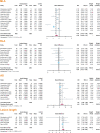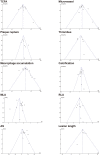Prevalence of Healed Plaque and Factors Influencing Its Characteristics Under Optical Coherence Tomography in Patients With Coronary Artery Disease: A Systematic Review, Meta-Analysis, and Meta-Regression
- PMID: 34881310
- PMCID: PMC8645588
- DOI: 10.3389/fcvm.2021.761208
Prevalence of Healed Plaque and Factors Influencing Its Characteristics Under Optical Coherence Tomography in Patients With Coronary Artery Disease: A Systematic Review, Meta-Analysis, and Meta-Regression
Abstract
Aim: The purpose of this study was to determine the prevalence of healed plaque and its characteristics under optical coherence tomography (OCT) through a formal systematic review, meta-analysis, and meta-regression. Methods and Results: Thirteen studies were selected from MEDLINE, EMBASE, Cochrane, and online databases. The overall incidence of healed plaques was 40% (95% CI: 39-42), with 37% (95% CI: 35-39) in patients with acute coronary syndrome (ACS) and with 46% (95% CI: 43-49) in patients with stable angina pectoris (SAP). The incidence of healed plaque among culprit plaques (48%, 95% CI: 46-50) was nearly two times higher than that among non-culprit plaques (24%, 95% CI: 21-27). The incidence of thin cap fibroatheroma (TCFA), plaque rupture, microvessel, macrophage accumulation, and calcification was significantly higher in the healed plaque group. Meta-regression revealed an association between smoking (P = 0.033) and healed plaque rupture. Gender (P = 0.047) was independently associated with macrophage accumulation, and mean low-density lipoprotein cholesterol (LDL-C) was independently associated with microvessel. Conclusions: In summary, with a total incidence of 40%, the incidence of healed plaques under OCT was higher in SAP than in ACS, and higher in culprit plaques than in non-culprit plaques. Higher incidence of TCFA, plaque rupture, microvessel, macrophage accumulation, and calcification was found in the healed-plaque group. Smoking, gender, and mean LDL-C level were associated with healed-plaque characteristics.
Keywords: characteristics; coronary artery disease; healed plaque; meta-analysis; meta-regression; optical coherence tomography; prevalence; systematic review.
Copyright © 2021 Feng, Liu, Yang, Zhai, Zhou and Guo.
Conflict of interest statement
The authors declare that the research was conducted in the absence of any commercial or financial relationships that could be construed as a potential conflict of interest.
Figures






Similar articles
-
Healed Culprit Plaques in Patients With Acute Coronary Syndromes.J Am Coll Cardiol. 2019 May 14;73(18):2253-2263. doi: 10.1016/j.jacc.2018.10.093. J Am Coll Cardiol. 2019. PMID: 31072568
-
Prevalence and predictors of culprit plaque rupture at OCT in patients with coronary artery disease: a meta-analysis.Eur Heart J Cardiovasc Imaging. 2016 Oct;17(10):1128-37. doi: 10.1093/ehjci/jev283. Epub 2015 Oct 27. Eur Heart J Cardiovasc Imaging. 2016. PMID: 26508517 Review.
-
Predictors for layered coronary plaques: an optical coherence tomography study.J Thromb Thrombolysis. 2020 Nov;50(4):886-894. doi: 10.1007/s11239-020-02116-5. J Thromb Thrombolysis. 2020. PMID: 32306291
-
Healed Plaques in Patients With Stable Angina Pectoris.Arterioscler Thromb Vasc Biol. 2020 Jun;40(6):1587-1597. doi: 10.1161/ATVBAHA.120.314298. Epub 2020 Apr 16. Arterioscler Thromb Vasc Biol. 2020. PMID: 32295419
-
Coronary Atherosclerotic Phenotype and Plaque Healing in Patients With Recurrent Acute Coronary Syndromes Compared With Patients With Long-term Clinical Stability: An In Vivo Optical Coherence Tomography Study.JAMA Cardiol. 2019 Apr 1;4(4):321-329. doi: 10.1001/jamacardio.2019.0275. JAMA Cardiol. 2019. PMID: 30865212 Free PMC article.
Cited by
-
Intracoronary Imaging of Vulnerable Plaque-From Clinical Research to Everyday Practice.J Clin Med. 2022 Nov 9;11(22):6639. doi: 10.3390/jcm11226639. J Clin Med. 2022. PMID: 36431116 Free PMC article. Review.
-
Detecting vulnerable carotid plaque and its component characteristics: Progress in related imaging techniques.Front Neurol. 2022 Sep 14;13:982147. doi: 10.3389/fneur.2022.982147. eCollection 2022. Front Neurol. 2022. PMID: 36188371 Free PMC article. Review.
-
Predictors and morphological properties of culprit healed plaques in patients with angina pectoris.Clin Cardiol. 2022 Dec;45(12):1199-1210. doi: 10.1002/clc.23896. Epub 2022 Sep 7. Clin Cardiol. 2022. PMID: 36072996 Free PMC article.
-
Superficial Calcified Plates Associated to Plaque Erosions in Acute Coronary Syndromes.Life (Basel). 2023 Aug 11;13(8):1732. doi: 10.3390/life13081732. Life (Basel). 2023. PMID: 37629589 Free PMC article.
References
Publication types
LinkOut - more resources
Full Text Sources
Miscellaneous

